Page 46 of 543
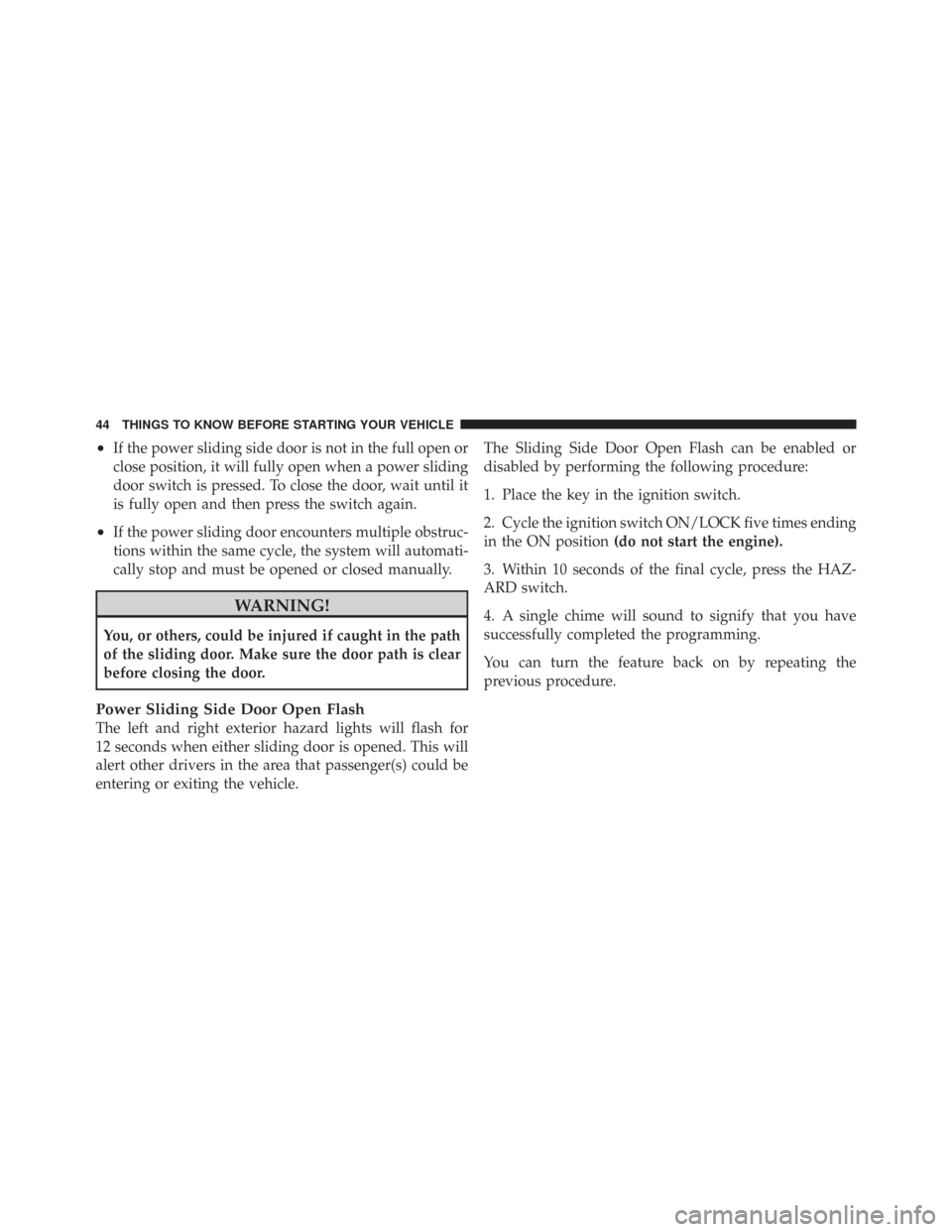
•If the power sliding side door is not in the full open or
close position, it will fully open when a power sliding
door switch is pressed. To close the door, wait until it
is fully open and then press the switch again.
•If the power sliding door encounters multiple obstruc-
tions within the same cycle, the system will automati-
cally stop and must be opened or closed manually.
WARNING!
You, or others, could be injured if caught in the path
of the sliding door. Make sure the door path is clear
before closing the door.
Power Sliding Side Door Open Flash
The left and right exterior hazard lights will flash for
12 seconds when either sliding door is opened. This will
alert other drivers in the area that passenger(s) could be
entering or exiting the vehicle.The Sliding Side Door Open Flash can be enabled or
disabled by performing the following procedure:
1. Place the key in the ignition switch.
2. Cycle the ignition switch ON/LOCK five times ending
in the ON position
(do not start the engine).
3. Within 10 seconds of the final cycle, press the HAZ-
ARD switch.
4. A single chime will sound to signify that you have
successfully completed the programming.
You can turn the feature back on by repeating the
previous procedure.
44 THINGS TO KNOW BEFORE STARTING YOUR VEHICLE
Page 52 of 543
When the RKE transmitter button is pressed and the
Flash Lights feature is enabled, the tail lights will flash to
signal that the liftgate is opening or closing.
WARNING!
During power operation, personal injury or cargo
damage may occur. Ensure the liftgate travel path is
clear. Make sure the liftgate is closed and latched
before driving away.
NOTE:
•If anything obstructs the power liftgate while it is
closing or opening, the liftgate will automatically
reverse to the closed or open position, provided it
meets sufficient resistance.
•There are also pinch sensors attached to the side of the
liftgate opening. Light pressure anywhere along these
strips will cause the liftgate to return to the open
position.Rear Power Liftgate Switch
50 THINGS TO KNOW BEFORE STARTING YOUR VEHICLE
Page 66 of 543
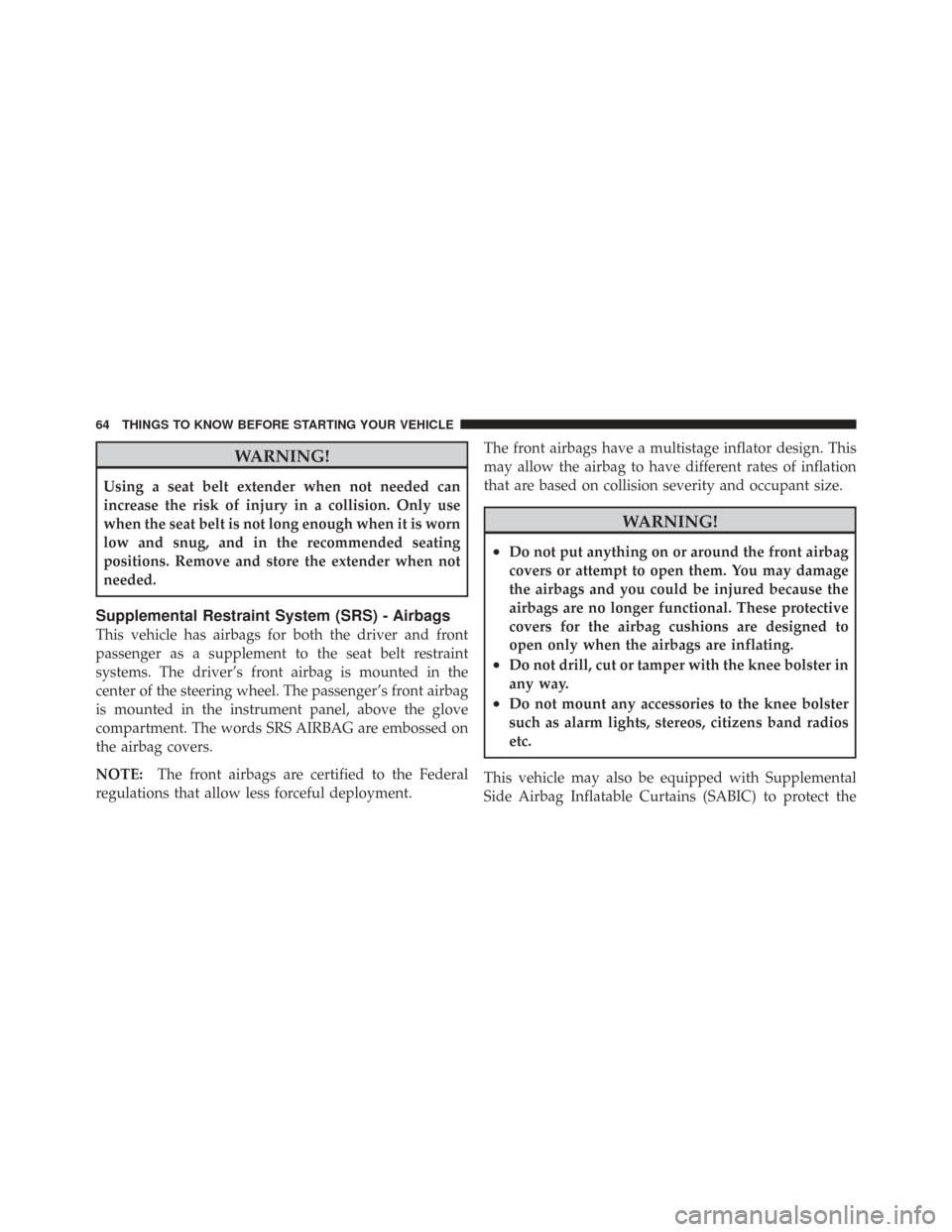
WARNING!
Using a seat belt extender when not needed can
increase the risk of injury in a collision. Only use
when the seat belt is not long enough when it is worn
low and snug, and in the recommended seating
positions. Remove and store the extender when not
needed.
Supplemental Restraint System (SRS) - Airbags
This vehicle has airbags for both the driver and front
passenger as a supplement to the seat belt restraint
systems. The driver’s front airbag is mounted in the
center of the steering wheel. The passenger’s front airbag
is mounted in the instrument panel, above the glove
compartment. The words SRS AIRBAG are embossed on
the airbag covers.
NOTE:The front airbags are certified to the Federal
regulations that allow less forceful deployment. The front airbags have a multistage inflator design. This
may allow the airbag to have different rates of inflation
that are based on collision severity and occupant size.
WARNING!
•Do not put anything on or around the front airbag
covers or attempt to open them. You may damage
the airbags and you could be injured because the
airbags are no longer functional. These protective
covers for the airbag cushions are designed to
open only when the airbags are inflating.
•Do not drill, cut or tamper with the knee bolster in
any way.
•Do not mount any accessories to the knee bolster
such as alarm lights, stereos, citizens band radios
etc.
This vehicle may also be equipped with Supplemental
Side Airbag Inflatable Curtains (SABIC) to protect the
64 THINGS TO KNOW BEFORE STARTING YOUR VEHICLE
Page 72 of 543

WARNING!
Ignoring the Airbag Warning Light in your instru-
ment panel could mean you won’t have the airbags to
protect you in a collision. If the light does not come
on, stays on after you start the vehicle, or if it comes
on as you drive, have the airbag system checked right
away.
Front and Side Impact Sensors
Impact Sensors trigger airbag deployment in front and
side impacts, and aid the ORC in determining appropri-
ate response to impact events. Additional sensors in the
ORC determine the level of airbag deployment and
provide verification.
Supplemental Side Airbag Inflatable Curtain
(SABIC) — If Equipped
The ORC deploys the SABIC during a collision with
other vehicles and during collisions where the impact isconfined to a particular area of the vehicle. In these
events, the ORC will deploy the SABIC only on the
impact side of the vehicle.
NOTE:
The ORC will also detect and protect for rollover
events. In a rollover the pretensioners and/or SABIC
airbags will deploy on both sides of the vehicle.
Enhanced Accident Response System
In the event of an impact causing airbag deployment, the
vehicle communication network intact, and the power
intact, the ORC will determine if the event is severe
enough for the Enhanced Accident Response System to
perform the following functions:
•Cuts off fuel to the engine.
•Flashes hazard lights as long as the battery has power
or until the ignition key is turned off.
70 THINGS TO KNOW BEFORE STARTING YOUR VEHICLE
Page 73 of 543
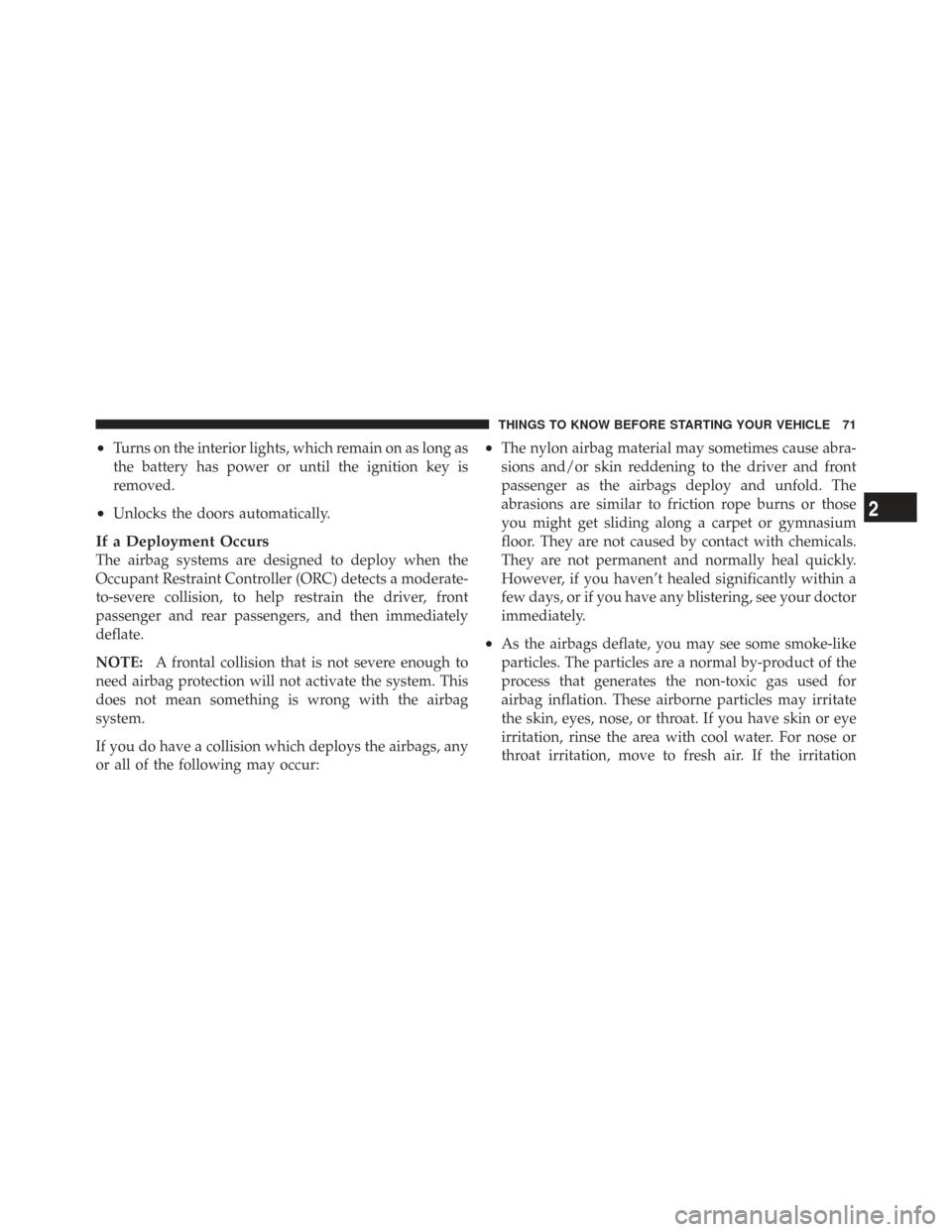
•Turns on the interior lights, which remain on as long as
the battery has power or until the ignition key is
removed.
•Unlocks the doors automatically.
If a Deployment Occurs
The airbag systems are designed to deploy when the
Occupant Restraint Controller (ORC) detects a moderate-
to-severe collision, to help restrain the driver, front
passenger and rear passengers, and then immediately
deflate.
NOTE:A frontal collision that is not severe enough to
need airbag protection will not activate the system. This
does not mean something is wrong with the airbag
system.
If you do have a collision which deploys the airbags, any
or all of the following may occur:
•The nylon airbag material may sometimes cause abra-
sions and/or skin reddening to the driver and front
passenger as the airbags deploy and unfold. The
abrasions are similar to friction rope burns or those
you might get sliding along a carpet or gymnasium
floor. They are not caused by contact with chemicals.
They are not permanent and normally heal quickly.
However, if you haven’t healed significantly within a
few days, or if you have any blistering, see your doctor
immediately.
•As the airbags deflate, you may see some smoke-like
particles. The particles are a normal by-product of the
process that generates the non-toxic gas used for
airbag inflation. These airborne particles may irritate
the skin, eyes, nose, or throat. If you have skin or eye
irritation, rinse the area with cool water. For nose or
throat irritation, move to fresh air. If the irritation
2
THINGS TO KNOW BEFORE STARTING YOUR VEHICLE 71
Page 98 of 543
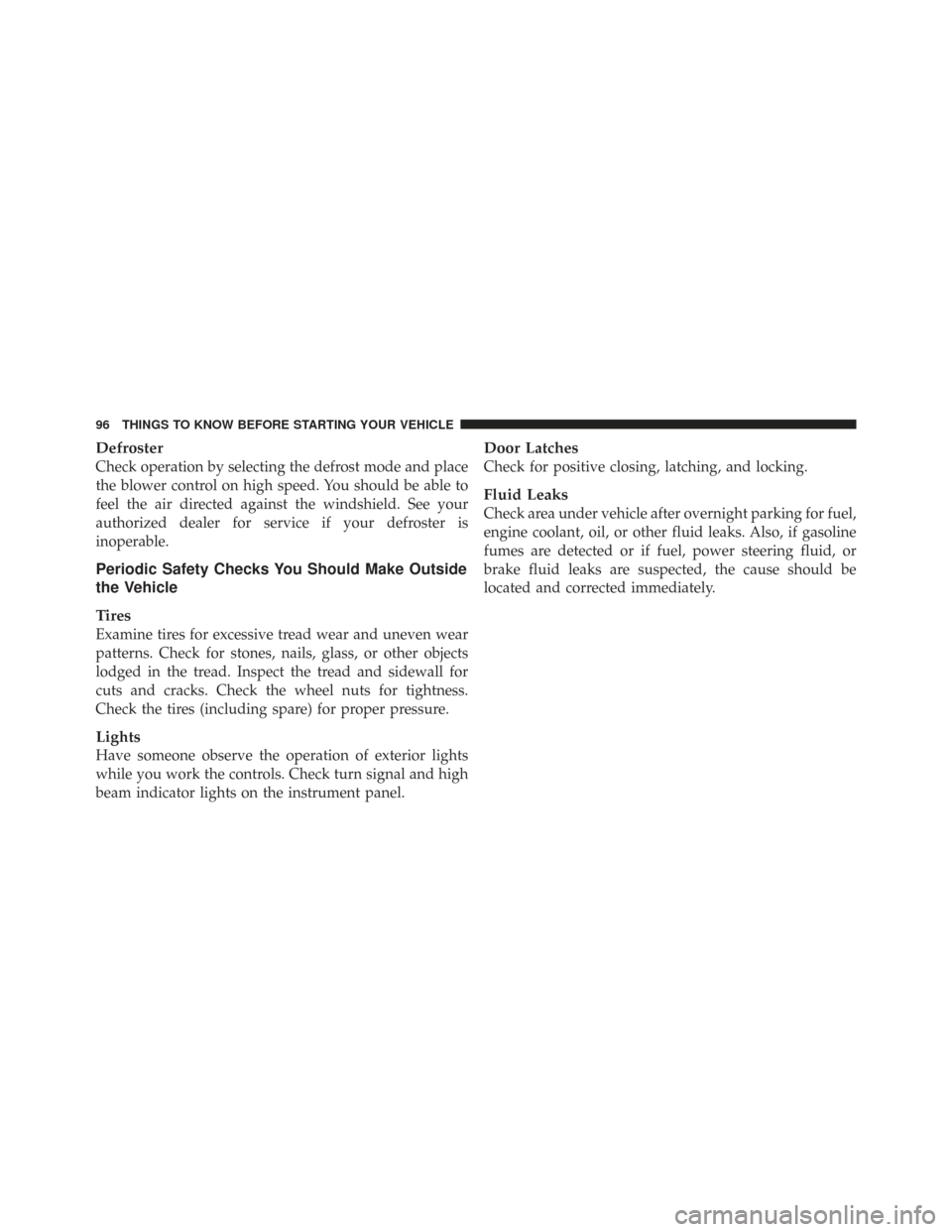
Defroster
Check operation by selecting the defrost mode and place
the blower control on high speed. You should be able to
feel the air directed against the windshield. See your
authorized dealer for service if your defroster is
inoperable.
Periodic Safety Checks You Should Make Outside
the Vehicle
Tires
Examine tires for excessive tread wear and uneven wear
patterns. Check for stones, nails, glass, or other objects
lodged in the tread. Inspect the tread and sidewall for
cuts and cracks. Check the wheel nuts for tightness.
Check the tires (including spare) for proper pressure.
Lights
Have someone observe the operation of exterior lights
while you work the controls. Check turn signal and high
beam indicator lights on the instrument panel.
Door Latches
Check for positive closing, latching, and locking.
Fluid Leaks
Check area under vehicle after overnight parking for fuel,
engine coolant, oil, or other fluid leaks. Also, if gasoline
fumes are detected or if fuel, power steering fluid, or
brake fluid leaks are suspected, the cause should be
located and corrected immediately.
96 THINGS TO KNOW BEFORE STARTING YOUR VEHICLE
Page 101 of 543
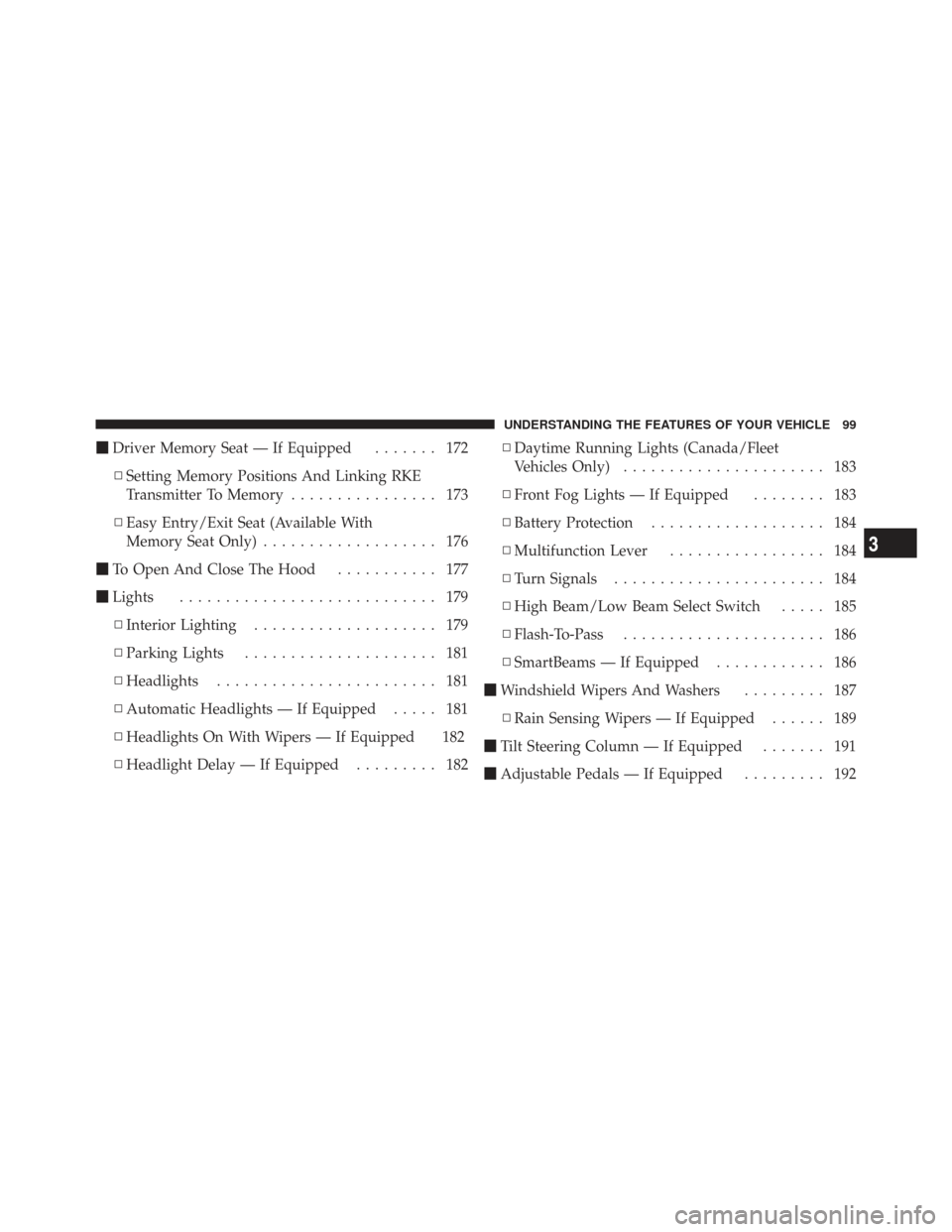
�Driver Memory Seat — If Equipped ....... 172
▫ Setting Memory Positions And Linking RKE
Transmitter To Memory ................ 173
▫ Easy Entry/Exit Seat (Available With
Memory Seat Only) ................... 176
� To Open And Close The Hood ........... 177
� Lights ............................ 179
▫ Interior Lighting .................... 179
▫ Parking Lights ..................... 181
▫ Headlights ........................ 181
▫ Automatic Headlights — If Equipped ..... 181
▫ Headlights On With Wipers — If Equipped 182
▫ Headlight Delay — If Equipped ......... 182▫
Daytime Running Lights (Canada/Fleet
Vehicles Only) ...................... 183
▫ Front Fog Lights — If Equipped ........ 183
▫ Battery Protection ................... 184
▫ Multifunction Lever ................. 184
▫ Turn Signals ....................... 184
▫ High Beam/Low Beam Select Switch ..... 185
▫ Flash-To-Pass ...................... 186
▫ SmartBeams — If Equipped ............ 186
� Windshield Wipers And Washers ......... 187
▫ Rain Sensing Wipers — If Equipped ...... 189
� Tilt Steering Column — If Equipped ....... 191
� Adjustable Pedals — If Equipped ......... 192
3
UNDERSTANDING THE FEATURES OF YOUR VEHICLE 99
Page 108 of 543
Illuminated Vanity Mirrors — If Equipped
An illuminated vanity mirror is located on the sun visor.
To use the mirror, rotate the sun visor down and swing
the mirror cover upward. The lights turn on automati-
cally. Closing the mirror cover turns off the lights.
BLIND SPOT MONITORING — IF EQUIPPED
The Blind Spot Monitoring (BSM) system uses two radar-
based sensors, located inside the rear bumper fascia, to
detect Highway licensable vehicles (automobiles, trucks,
motorcycles etc.) that enter the blind spot zones from the
rear/front/side of the vehicle.
Illuminated Mirror
Rear Detection Zones
106 UNDERSTANDING THE FEATURES OF YOUR VEHICLE